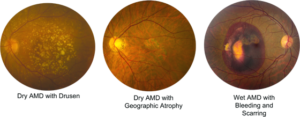
The macula is the part of the retina, which provides us with central vision and allows us to see fine detail, such as, reading, writing, face recognition or watching television. Macular Degeneration is a condition in which the macula gets damaged. When it is due to aging, it is known as Age-related Macular Degeneration (AMD).

Most often vision loss starts in one eye. Because the healthy eye compensates for the loss of vision in the damaged eye, macular degeneration may initially go unnoticed. In many cases it will ultimately affect vision in the other eye as well.

Dry AMD: The retina becomes thinner (atrophic) and stops functioning. This may cause some people to detect “blank” areas in their central vision. The vision loss due to this Dry AMD is not very severe as compared to the wet AMD. While there is no treatment available for people with dry AMD, various low vision aids are available to help these people see well and perform daily activities
Wet AMD:Abnormal blood vessels grow under the macula. These abnormal vessels leak fluid and blood, and thus cause swelling and scar tissue formation, leading to distorted vision and severe vision loss.
The vision lost due to AMD is generally irreversible, and the treatment methods try to preserve vision but can not improve vision. Hence it is important to detect this disease at an early stage, before it has caused significant vision loss.
In the early stages of AMD, a person’s vision may become blurred or distorted(wavy). A retinal examination, with the help of special tests like OCT etc. can help the eye specialist to diagnose the condition. Since many times the patient may not notice the initial distortion or blurring of vision, the key to preventing vision loss due to AMD is regular eye examinations for patients above 40 years of age.
Untreated, AMD is known to progress and lead to further loss of vision, the rate of deterioration being faster in the wet type. Antioxidants and Multivitamin capsules may have a role in preventing or decreasing the speed of progression of the disease. In wet AMD, additional methods of treatment are required to arrest or at least retard the progression of the disease. Many methods have been tried and are being developed. The best suited treatment modality is decided by the eye specialist after discussing with the patient. One may need to use a combination of various therapies. The most popular and established modes of treatment are:
Conventional Laser: burns the abnormal blood vessels and thus stops the leakage. However, since it also damages the normal retina structures, it may itself lead to decreased vision. Hence, it is suitable only in selected cases where the new vessels are not very close to the central macular area.
Anti-VEGF Agents : The available agents are Bevacizumab (Avastin-TM) Ranjibizumab (Accentrix, Razumab) and Aflibercept (Eylea). When injected into your eye (intravitreal injection), it works by inhibiting the growth of abnormal blood vessels in the macula. By blocking the stimulus, it can stop the blood vessels leaking and growing. In many cases it actually causes the blood vessels to regress, and even improves vision.
